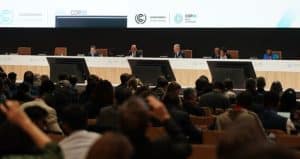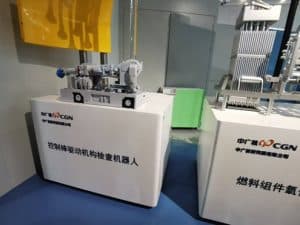Introduction to the Auther’s Background
Li Wanlin, an assistant researcher at the Lanzhou-based NGO Green Camel Bell (GCB), participated in COP29 as a member of GCB’s delegation. As an observer to the UNFCCC, GCB organized a side event, hosted an exhibition booth, and facilitated exchanges with other delegates during COP29, aiming to promote the active participation and influence of youth in climate-related issues.
Key Achievements and Global Commitments at COP29
Countries have pledged at least $300 billion annually by 2035 for developing countries to ramp up climate action[1]. Parties have reached an unprecedented new agreement on carbon markets and renewed promises to keep global warming within the 1.5℃ limit[2]….These are among the significant achievements of COP29.
The Conference of Parties (COP), under the United Nations Framework Convention on Climate Change (UNFCCC), brings together signatory countries to evaluate progress in combating climate change and to negotiate binding agreements. This year, the COP29 Presidency’s plan is based on two mutually reinforcing themes: to enhance ambition and to enable action[3]. A variety of panel sessions and meetings were held under these themes. In this report, we will highlight latest updates on youth involvement in climate action at COP29.

Image 1: COP29 in Action (Source: UNFCCC website)
Using Technology to Enable Climate Action
On November 16, the Green Zone panel session titled “Empowering Youth for a Digital Climate Revolution[4]” explored how digital technologies are transforming climate action. The session highlighted the vital role of young people in driving innovation and change. Discussions centered around the impact of digital tools in promoting sustainability, achieving financial inclusion through technology, and empowering youth to advocate for environmental causes. The event also featured a showcase for innovative digital platforms, applications, and AI-powered solutions designed to enable real-time participation in tackling climate challenges. In the realm of leveraging technology for environmental causes, the youth of Shenzhen hold a unique advantage. Growing up in a tech-driven city, many of us are well-versed in digital technologies, from AI to hardware innovations like drones. Technologies that were once science fiction dreams, such as drone-operated food delivery stations and extensive electric vehicle networks, with Shenzhen ranking 3rd globally[5] in EV coverage are now part of everyday life.
Shenzhen’s partnerships with various inland Chinese cities provide opportunities to apply these innovations, including advancing financial inclusion through tools like livestreaming. For young people seeking ways to contribute to sustainability, these avenues offer promising directions to explore and act upon.

Image 2: Experimental Delivery Drones in Shenzhen (Source: www.meituan.com)
Human Capital: Creating a Green Future Through Education
On Nov 18, the Green Zone hosted a panel discussion titled “Raising Human Capital[6] for Green Future,” which explored the vital role of human capital, particularly children and youth, in building a sustainable, low-carbon future. The panel emphasized the importance of equipping future generations with the knowledge, skills, and environmental awareness necessary to tackle pressing ecological challenges. Through education, young people can be empowered to turn their aspirations for sustainability into action and become leaders in the green transition.
In my view, this panel offers valuable inspiration not only for young people but also for current policymakers. Sustainability education should aim not only to raise awareness but also to enable tangible action. While the new generations are being educated with curriculum that integrates sustainability concepts across science and humanities, the materials often remain too vague and broad to drive meaningful change.
What we need is more up-to-date, locally relevant information. For example, when you turn on the lights, it’s worth knowing that the electricity may well come from clean power generated by the Daya Bay Nuclear Power Plant, China’s second nuclear plant and the first built through international cooperation. Our local museums, too, could use refreshing. While they rightfully celebrate Shenzhen’s revolutionary economic growth, they could also tell stories of the city’s efforts to preserve its natural beauty. By grounding education in local realities and successes, we can inspire a more informed and proactive approach to sustainability.

Image 3: Model of a Nuclear Plant Maintenance Robot at Daya Bay Nuclear Plant Museum (Source: Author)
Other Programs in Action
Beyond the professional panels, COP29 also features a youth climate delegates program, designed to equip young people with technical knowledge and skills needed to participate effectively in climate mitigation and adaptation policies. Many young activists from civil society organizations and government institutions took part in negotiation workshops and climate policy development sessions. This program emphasizes empowerment, and serves as a model for educational events that guide young people in contributing to both national and international climate strategies.
Additionally, events like “Youth at the Forefront of Climate Action”[7] provide platforms for young people to engage with policymakers, leaders and fellow activists. These forums allow youth to share innovative solutions, advocate for greater inclusion in decision-making processes, and ensure that their voices shape global climate initiatives.
As highlighted in COP29 coverage, the role of young people in climate and sustainability action is becoming increasingly significant. One day, the new generation will lead the charge for transformative change. COP29 offers valuable guidance on how to move towards, and it’s never too late to start taking action!
[1] https://www.climatechangenews.com/2024/11/23/fractious-cop29-lands-300bn-climate-finance-goal-dashing-hopes-of-the-poorest/
[2] COP29 UN Climate Conference Agrees to Triple Finance to Developing Countries, Protecting Lives and Livelihoods | UNFCCC
[3] COP29 Azerbaijan – United Nations Climate Change Conference (Source: UNFCCC)
[4] Panel Discussion on “Empowering Youth for a Digital Climate Revolution” Held at COP29 Green Zone
[5] Top 10: EV Cities | EV Magazine
[6] COP29 Green Zone Hosts Panel on Raising Human Capital for a Green Future
[7] COP29 Conference on “Youth at the Forefront of Climate Action” Held with the Participation of First Ladies (Source: Official Website of the President of the Azerbaijan Republic)



